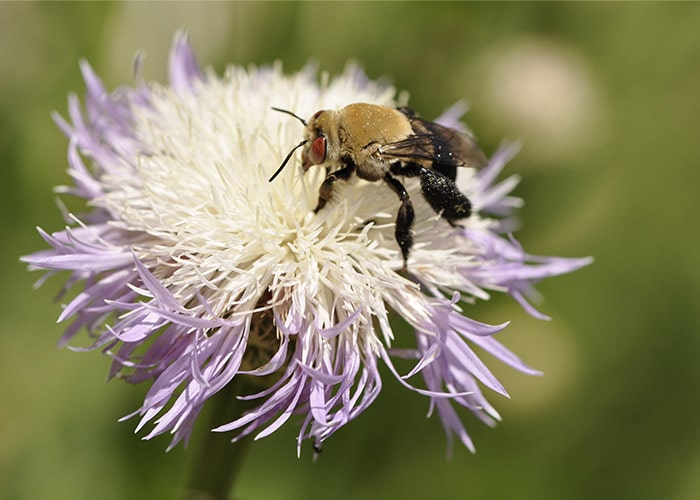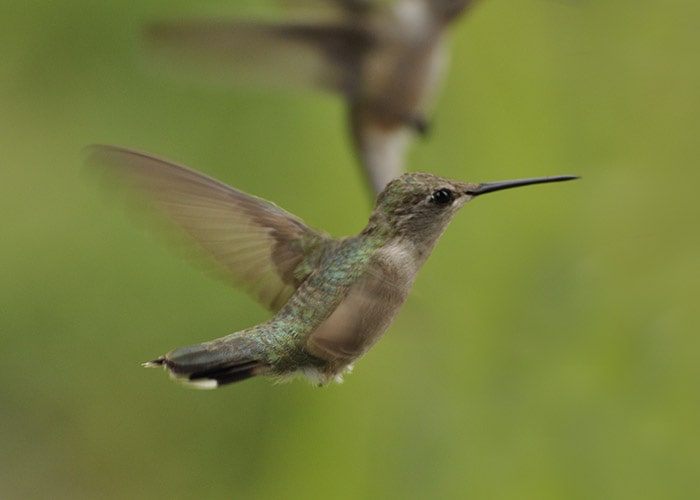Pollination
Pollination -- Century 21 Style
by Dave Green

About one third of all kept US honeybees have been trucked to California for the largest planned pollination event in the world. Nearly a million hives have been hauled into almond orchards to get those bees working early. Each year more almonds are planted and soon the demand will surpass a million hives.
The past few years have seen the loss of almost all wild honeybees, and kept hives have been cut by about half to around 3 million hives in the US. At the same time wild pollinators, such as bumblebees, orchard mason bees and leafcutter bees have been declining due to pesticide misuse, loss of habitat (suburban development, clearcut logging, changing farm practices) and general environmental degradation.
But fruit and vegetable crop yields have remained high, and even increased in some cases, because more and more beekeepers have become migratory, doing much more with less.
Last fall, hundreds of tractor trailers of bees were moved to California from Washington, Oregon, Montana, the Dakotas, Minnesota and other northern states. Their primary reason was to be ready for almonds, though they were moved in the fall to also take advantage of the milder winter in California.
Last month bees started arriving from Texas, Louisiana and other Gulf Coast states, even as far as Florida.
Much of the unloading is done by night, with forklifts to handle the hives in pallets of four. This year has been "mudville" due to the heavy rains of El Nino. In some cases, it has been impossible to get the bees directly into the orchards and they have had to settle for higher sites along the margins. In other places big tractors and even bulldozers are used to pull the trucks through the mud.

These strange midnight "cowboys" can be found in the coffee shops at daybreak in the almond country, coated with mud and dead tired. Beekeeping is not an easy life, and many beekeepers are known as "rugged individualists" or as "independent SOB's" depending on your perspective. But this almond crop, and other major US crops, totalling about ten billion dollars worth of produce, depend on these hard working guys.
As soon as the trucks are unloaded, the bees are given a gallon or two of high fructose corn syrup to stimulate the queen to lay more eggs. Bees that have a lot of babies to feed are better pollinators, because the brood requires protein-rich pollen. This means more workers will be going to deliberately gather pollen, rather than nectar. A nectar gathering bee will accomplish some pollination, but a pollen gathering bee will be about ten times more effective as a pollinator.
Theft is a major problem, especially when there is a shortage, and most of the beekeepers stay as close as possible to their bees. Whole truckloads of bees have been known to disappear in one night. Beekeepers have been known to keep the bees in the most junky possible equipment so as to make them unattractive to thieves. Humans and other creatures also can steal the syrup pails, as soon as the beekeeper's back is turned.
After almonds, many will be moving northward to the Yakima valley of Washington, and other apple growing sites. In recent years, some of the Florida truckloads of bees moved clear across the country again, to upstate NY for apples, then to Maine for blueberries, then to Michigan for pickle cucumbers, before returning to Florida for the winter.
Commercial beekeeping today is not about honey, so much as for pollination. Growers have to pay the beekeepers to get bees; they would not come unless they were paid, since most pollination crops yield little honey. Alfalfa, one of the few honey producing pollination crops, are stocked so heavily to maximize pollination, that there are too many hives to produce significant honey. This is another reason why growers must pay for the beekeeper service.
Pollination contracts account for the largest share of commercial beekeepers income today. Bees are moved to crops that are honey sources (like clover) to supplement the pollination business.

The business is not without hazards. Last year California authorities destroyed a tractor-trailer load of bees from the southeast, because fire ants were found in some dirt in the bottom of the pallets. If a truck wrecks or breaks down in a populated area, panicky authorities may destroy the load. They don't think about the fact that the $40,000 worth of bees may be going to pollinate a million dollars worth of fruit or nuts.
This kind of loss can sink a beekeeper, and there are only about 1600 commercial beekeepers left in the US. Insurance companies will provide cargo insurance for the beehives, but not for the bees, as it is just too risky. On a hot day, bees can die simply because the truck is caught in a traffic jam and cannot keep air moving to the bees. A chain reaction is started. The bees become overheated and become agitated, which creates more heat, which makes them still more agitated. In some cases the honeycomb literally melts down, killing brood and usually the hive as well.
A lot of bees used to be trucked in refrigerated trucks, which works better than open netted loads, as long as the reefer is able to keep up with the heat production capacity of the bees. But too many reefers failed and few are trucked this way today.
A friend of mine experienced a reefer failure about ten years ago. When he opened the back doors, all the bees were clinging to the walls and ceiling. The queens from various hives were intermingled and all the brood in the hives was dead.
To salvage them, he set out the hives, and put a scoop shovel of bees into each hive. Then he ordered 500 queens from a queen producer, which were hand delivered for speed. By that time, some of the bees had totally drifted out of some hives, but he tried again to equalize the bees, and added a queen to each.
He was finally able to salvage about half the hives, but they were too weak to do any pollination or honey production for that season. The trucker's cargo insurance refused to pay anything; they had a clause in the fine print.

Gardeners who fervently hope for a commercial beekeeper to be nearby, will not likely see honeybees in the spring. Most commercial bees will be in orchards for paid pollination. But later in the season, the bees may be spread around in "bee yards" of 40 or 50 hives, to make some honey. If one of these is nearby, you'll be guaranteed good pollination for your later garden, ie. cukes, melons, squash and pumpkins.
For apples and other home fruit, you might be able to strike a deal with a beekeeper to provide him or her a site for a bee yard, in exchange for a promise to leave one or two hives there during the spring fruit bloom. Most of the bees, of course will come in later. And, of course, this only works for folks who have a little acreage. To avoid community problems (kids especially), bee yards should be somewhat isolated and hidden.
More and more gardeners are finding that they cannot rely on other beekeepers, so they are getting a hive or two of their own. Call your local extension office to see if they or a local bee association are offering training courses for new beekeepers. If they are not, jack them up, because they should be.
Other gardeners are putting up mason bee homes, which are simple drilled wooden blocks, which are used by these solitary bee females for nesting sites. Stingless mason bees are excellent fruit pollinators, but not for garden veggies, because they go dormant after the spring.
Bumblebee culture is also a booming business, but so far is so expensive that it is mostly used for greenhouse production of tomatoes, peppers, strawberries, etc. Costs run around $200-300 for a colony of 50-100 bees. A visit by a bumblebee on your cuke blossom is worth about three visits by a honeybee, because the bumbler is so much more brawny and fuzzy. Bumblebees are poor for fruit, because their populations are very small early in the season. They are great pollinators for vegetables or very late blooming fruit, when their colonies are established.
One third of our food supply must have bees. Many gardeners don't realize that pollination is not an "on or off" thing. One bee going to a flower is not usually sufficient to make a quality fruit. Many flowers require 15 or 20 visits to make perfect fruit. Each time the bees come, they rub against the sticky pistil and smear on more pollen grains. A watermelon blossom requires about 1000 grains of pollen, evenly spread across the three lobes of the pistil.
When you look at a sliced melon, regard the seeds. Each white, unpollinated seed represents potential that is not realized. If there are many white seeds, the fruit will never attain full size and sweetness. How many times have you been disappointed when you tasted a poorly pollinated melon? Knotty or curled cukes, flat-tasting cantaloupes, small lopsided apples and many other fruits and veggies tell the tale of growers who assumed that wild pollinators would be sufficient, and they weren't. Nowadays pollination must be managed, just the same as fertility, pest control and other aspect of growing fruits and vegetables.
Critical Terms
"Pollinator" - a bee or other agent that transfers pollen from one flower to another, thus accomplishing cross pollination of the seeds, which stimulates development of high quality fruit flesh.
"Pollenizer" - a plant variety that provides compatible pollen at the same time as the plant to be pollinated (ie. a "daddy" plant). Plants do not "pollinate" other plants; bees do that. And no plant variety is a "pollinator," again, that is the bee's job.
Warning: If you talk to an "authority who talks about "pollinator" plants, or plants "pollinating" other plants, you'd be wise to check another authority whose thinking isn't so muddy. Plants pollenize other plants, bees pollinate them. I would not buy from a nurseryman who does not know the difference.
Pollinator@aol.com Dave Green -- Hemingway, SC USA
